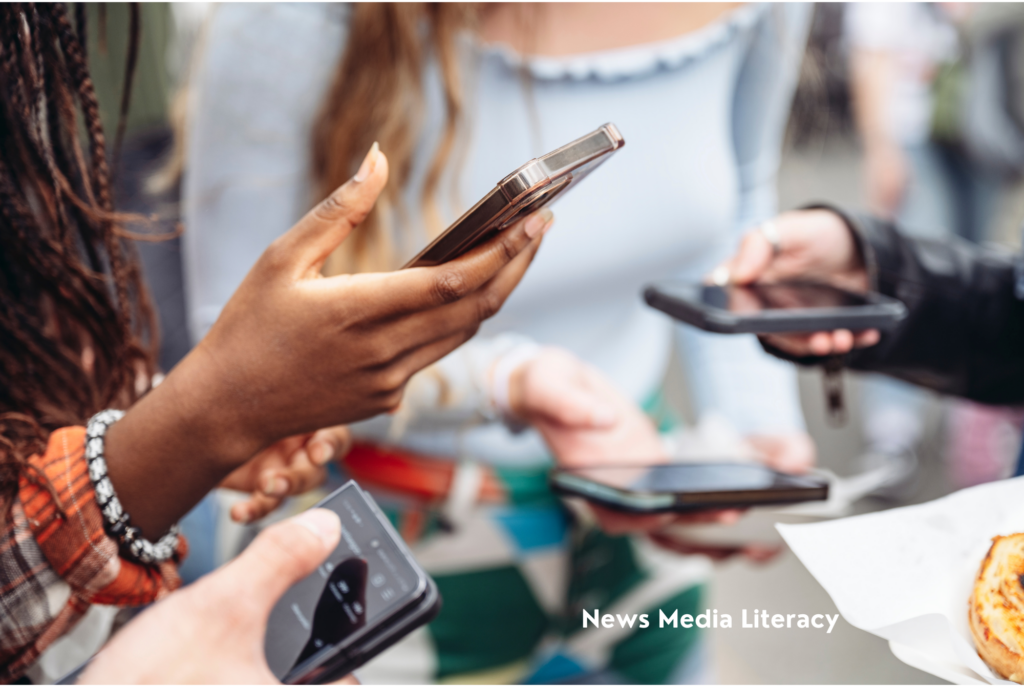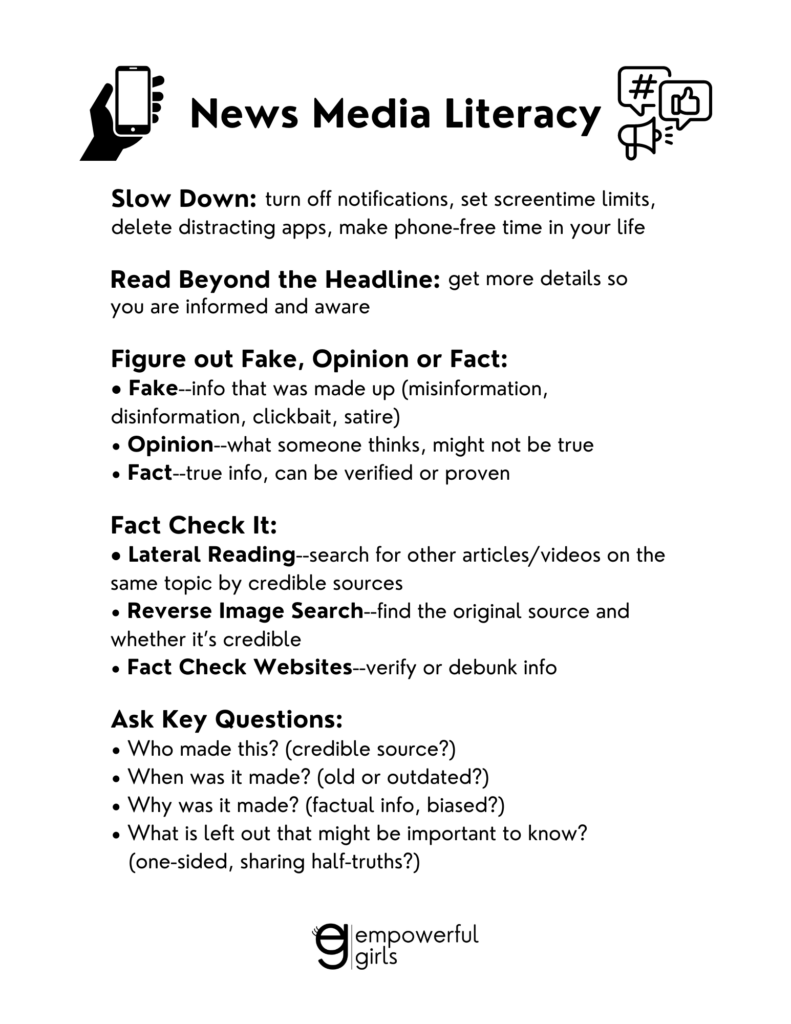
Why You Need Media Literacy
Nerdy as it might sound, I’m really into Media Literacy. I studied it in college for my degree in journalism. And since then, over the past two decades, media itself has expanded exponentially, thereby increasing the need for media literacy. To me, media literacy is about being a mindful media consumer, communicator, and creator. Media literacy is absolutely crucial for people to develop because we live in a digital world–we use screens for news, education, entertainment, communication, shopping, and more. And if you haven’t heard yet–you can’t believe everything you read OR see OR hear on the internet. Which is a huge bummer, honestly; I wish more people sharing media would have integrity. But the fact is, there’s a lot of false information out there. And the only way to sift though it is through media literacy.
There are a lot of topics that fall under the umbrella of media literacy, and I’ve touched on a few already: in episode 63 we analyzed media through a series of tests, and in episode 69 we talked about being AI aware. I really could spend days teaching you about media literacy (if you’d actually like a workshop on this, let me know), but for this episode, I want to cover some essential tools that will help you navigate news media in your digital world.
Slow Down
In 2015 TIME Magazine shared a study from Microsoft Corp. that showed from the year 2000 to 2015, people’s attention spans dropped from 12 seconds to eight seconds–which is less than a goldfish has. Can you guess why this is happening? The digital world we live in is to blame. We spend most of our day on devices, and operate them at lightning speed–endlessly scrolling, mindlessly toggling between apps, skipping through videos. These habits have shrunk our attention spans and impacted how we live our daily lives. The constant digital distractions at our fingertips are getting in the way of living mindfully. As it relates to media literacy, our diminishing attention spans make it difficult for us to intentionally consider the digital digest we’re consuming. It’s hard to practice media literacy if you can’t concentrate for more than a few seconds. So again, my advice is to slow down. Device and app settings are a great place to start. Turn off notifications. Set screen time limits on apps. Schedule downtime. Create a difficult phone password. Delete distracing apps while doing homework or on the weekend so you can enjoy it unplugged. Set boundaries for yourself, like phone-free dinners and hangouts with friends. Sit still and meditate or just be bored for a bit, and see what ideas pop up. Go for a walk around your neighborhood or spend time in nature without your phone–trade some blue light for sunlight. These practices will help you slow down and create space to be more mindful and purposeful with how you spend your time in real life and online.
Read Beyond The Headline
A lot of people don’t do this, actually. Probably because of our shorter attention spans, amirite? When we read a headline or watch a short video clip, we’re only getting a snippet of information. If that’s as far as we go, we’re missing the rest of the story, getting incomplete or even incorrect info. On top of that, headlines and titles are written to hook viewers’ and readers’ attention using the fewest words possible, because they know people will only pause for a moment before scrolling on to something else, so they’ve gotta catch you while they can. But a short headline doesn’t even begin to cover the basic details of an event or information. Even the preview text is insufficient. Look, I’ve been guilty of only reading a headline too, so we’re all gonna take this advice and practice media literacy by reading beyond the headline.
Figure out Fake, Opinion or Fact
Can you spot the difference between them? It can be tricky because information is no longer limited to books, newspapers or network evening broadcasts. News is constantly flowing, being passed around the world via messaging apps and social media. And what’s being shared isn’t just the facts–people are blasting out their opinions, exaggerating, and even lying to your face. So how can you tell which is which?
Fake News: This is a broad term for information that was made up. And there are a few types of Fake News. There’s Misinformation, which is inaccurate info spread regardless of the intent–sometimes we get details wrong. But certain people turn Misinformation into something far worse: Disinformation. This is false info and edited or AI images intentionally created and shared to spread lies and mislead people. Disinformation is often used by governments, organizations, or public figures that want to control people and outcomes. Another type of Fake News is Clickbait–catchy headlines that reel you in with their shock factor or sensational wording like “You won’t believe …” Clickbait is often used for advertisements disguised as news; it’s also a tactic used with Disinformation. The fourth type of Fake News is Satire. Some pictures/videos/headlines we see are actually a joke, ironic, or exaggerated. There are even satire news organizations, like The Onion–one time they reported an ice skater fell through the ice at a Winter Olympics, and some people thought it was real (which it wasn’t, there’s no lake underneath an indoor ice rink). The National Library of Australia has a great guide on “What is Fake News, Misinformation and Disinformation.”
Opinion: Sometimes people share information along with their take on it, but someone’s thoughts don’t make it a fact; they make it an opinion. Have you heard of an editorial? That’s when someone’s opinion gets published in a newspaper or magazine. And opinions are shared in every form of media–network news channels, podcasts, social media. Everyone seems to have a hot take on everything nowadays, but remember, what someone thinks might not be true. It’s important to be able to distinguish between what’s someone’s opinion and what’s an actual fact. PBS and Media Wise has a helpful video on “Separating Fact from Opinion and Satire”
Fact: The great Sharon McMahon said, “Facts don’t require your approval.” And people with opinions don’t really like that. But facts are true, can be verified, can be proven. Facts have receipts. In a perfect world, all facts shared by news media would be objective. However, Bias usually gets in the way. Media Bias is when a news organization favors certain people, companies, groups or even ideas. This makes the “facts” they share not objective–it’s like a mix of facts and opinion. The way facts are phrased, the points of view shared, their logic, how they make conclusions, even the choice of photos or images used are all part of Media Bias. Some news organizations are very biased, and others are pretty neutral. If you’re curious, check out AllSides.com’s Media Bias checker to see the bias range of multiple news organizations.
Fact Check It
I don’t think we fact check information as often as we should. Sometimes we hear or see something and automatically believe it–and share it–without taking a moment to verify it (that’s why we need to slow down). It can also be hard to tell what’s real because the information, pictures, and graphics seem legitimate. So how can you fact check it? Here are few quick and effective ways.
Lateral Reading. Verify what you’re reading/seeing by searching for other articles/videos on the same topic shared by credible sources. Search by using keywords, specific dates, people or places mentioned in the original article you’re verifying. If you can’t find anything that’ll back it up, it’s probably fake.
Reverse image search. Particularly because of AI and digital editing, this is a necessity. You want to search for the original source of the image, and when you find it, see if it’s from a credible source and figure out if it’s Fake, Opinion or Fact.
Fact Check Websites. Run the info through a Fact Checker to see if it’s legit. Computers can search and process a lot faster than the human brain. Work smarter not harder. Common Sense Media has a list of Fact Check Websites along with their own review of each.
Ask Key Questions
Analyzing the media you consume is crucial. Asking questions using critical thinking skills will help you decode media and see what’s behind the curtain. The National Association of Media Literacy Education, better known as NAMLE, created a list of “Key Questions to Ask When Analyzing Media Experiences.” They listed several questions so I’ll highlight a few.
- Who made this? This will help you know if it’s a credible source.
- When was it made? Maybe it’s old or outdated.
- Why was it made? Is it sharing factual information, or is it biased trying to persuade me?
- What is left out that might be important to know? Perhaps it’s one-sided or sharing half-truths.
These questions and more will help you decode media and not get duped.
This was a crash course on news media literacy. My aim is to help you see media differently. Since media is a significant part of our lives, it’s important to critically assess the media we engage with so we’re aware of the messages being shared and what’s behind them. As you practice media literacy skills you’ll become a more mindful media consumer, communicator, and creator.
News Media Literacy Poster Printable
To help you remember all of this, I created a “News Media Literacy” poster for you to print out, personalize, and post on your wall where you’ll see it, remember it, practice it, and believe it — that’s the important part.
Resources
If you have a topic suggestion, I’d love to hear from you! Send an email (tweens get the OK from your parents) to hello@EmpowerfulGirls.com .
If you have social media already, follow me on Insta or tiktok @empowerfulgirls. I’m not encouraging or endorsing social media, but I’m on there to offer an unfiltered, uplifting alternative to what’s in your feed. Remember to get on the email list for the newsletter!
Also, if you enjoy listening to 10 for Teens + Tweens, I would truly appreciate you telling your friends about this podcast or leaving a review so others can find it and feel uplifted, too! Your support means the world to me!
